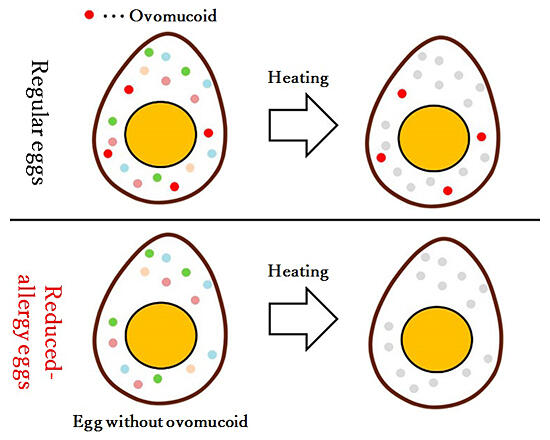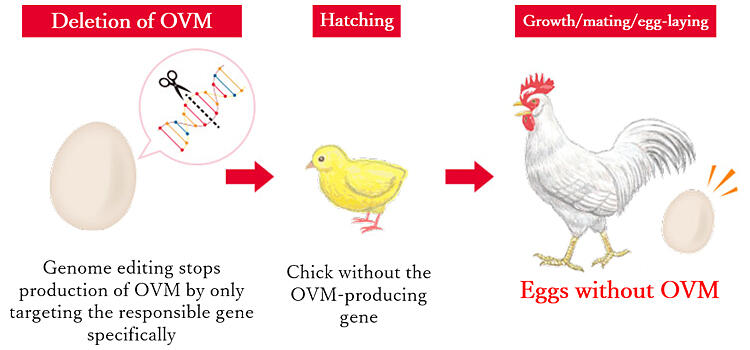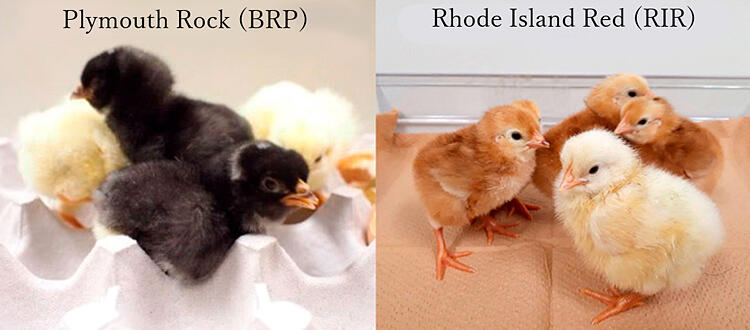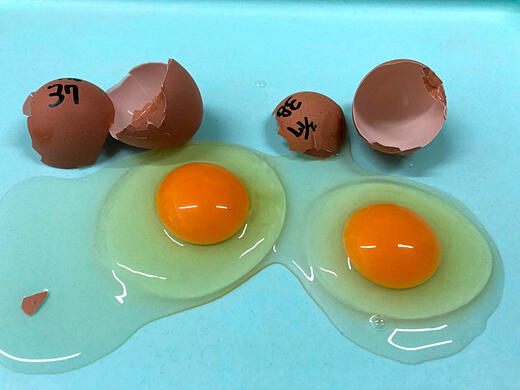An industry−academia collaborative group has created hen's eggs that lack ovomucoid (OVM), one of the substances responsible for egg allergy, for children suffering from severe hen's egg allergy through the use of genome technology, a technique that allows the manipulation of an organism's DNA. The eggs that are produced after editing and repeated breeding do not contain OVM and have no other genetic abnormalities. The group will investigate the presence or absence of allergic reactions to these eggs when eaten cooked and aim to commercialize them. They also hypothesize that these eggs may be useful in the production of medical vaccines.
Using gene editing to remove allergens that cannot be erased by heat
The group that undertook this research was led by Professor Hiroyuki Horiuchi of the Graduate School of Integrated Sciences for Life at Hiroshima University and included members from the Institute of Technology Solutions in R&D Division at Kewpie Corporation.
Horiuchi has family members who suffer from severe food allergies. In the case of his oldest son, even a trace amount of egg produces an allergic reaction. He stated, "When we go on a family trip, we cannot buy souvenirs, and my family members cannot get vaccinated for long trips. I wondered if there was anything I could do for my family."
Kewpie produces numerous egg products, such as mayonnaise. According to them, the major cause of food-related allergies is eggs, particularly egg white proteins. As an "egg company," they are striving to reduce the number of people suffering from egg allergies and to expand food options.
In 2013, Horiuchi and Kewpie started an industry−academia collaboration. Although most allergens undergo denaturation, that is, loss of characteristics, through exposure to sufficient heat, OVM is unlikely to be denatured by heat, which could be the cause of egg allergies. For producing eggs without OVM, Horiuchi and his colleagues considered that it may be helpful to cut out the genetic material that produces OVM. They employed genome editing technology in their research.

(provided by Kewpie)
Utilization of the genome editing technology developed at Hiroshima University
For genome editing that can produce eggs without this allergen, the Horiuchi group considered that it would be necessary to repeat crossbreeding of genetically edited chickens many times and to avoid recreating allergens because of slight deviations in genetic information.
Hiroshima University has independently developed a genome-editing technology, named "Platinum TALEN," which allows editing of the DNA closer to the point in the DNA where protein production begins, to prevent the production of even small sections of protein in error. They applied this technique in their research.

(provided by Kewpie)
Genetic recombination and genome editing are different from each other. Genetic modification, which must be indicated in food labels, is a method of inserting a foreign gene into an organism's DNA, whereas genome editing uses mutation of the DNA. Using genome editing to remove a particular function is referred to as the "knockout" technique. The group applied this technique to remove OVM production capacity from these chickens.
Repeated mating shows no impact on other genes
If only the fertilized eggs of organisms other than birds are edited, the genetic change will be passed on to the next generation. However, this method cannot be applied to chickens, as it takes 15 min for fertilization, 3 h for albumen formation, 1.5 h for eggshell membrane formation, and 20 h for shell formation. In the laboratory, it is difficult to make sure that the timing is right for the knockout reaction. Horiuchi's group created the OVM knockout eggs by culturing egg stem cells, performing OVM knockout in these cells, returning the cells to the eggshell, culturing them again, and waiting for 3 days.
For these OVM-knockout eggs, the issue of intellectual property rights could not be addressed if they crossed only one breed of chickens. Therefore, they treated two breeds to allow commercial implementation. They hatched the chicks from the prepared eggs, reared them as chickens, let them lay eggs, and then confirmed whether or not the eggs contained OVM. They confirmed that eggs that were laid even after repeated mating still did not contain OVM. After repeated crossbreeding, they examined if any other genetic abnormalities were present and observed that the genome editing had had no effect on other genes.

(provided by Hiroshima University)

(provided by Professor Horiuchi, Hiroshima University)
When the student members of the Horiuchi laboratory tasted and compared OVM-removed and regular eggs, they commented, "The egg whites of OVM-removed eggs may be a little hard." However, their taste and appearance differed very little. In the future, together with Kewpie and with the doctors at Sagamihara Hospital (Sagamihara City, Kanagawa Prefecture), they will conduct an allergic reaction test using the serum of allergic patients. They will also check if an allergic reaction occurs when these patients actually eat sweets and side dishes prepared with OVM-removed eggs. They plan to identify what form of processing of the eggs is required to ensure that they can be eaten safely.
Expectations for applications in chicken-egg derived vaccine production
They also anticipate applications of this research in fields other than food. Horiuchi's laboratory has a device that can detect extremely small amounts of OVM. Various vaccines produced using chicken eggs contain some picograms (one trillionth of a gram) of OVM. Because of this, patients with severe egg allergy can only be vaccinated fairly infrequently. Horiuchi believes that the use of OVM-removed eggs may resolve this problem.
The research results appeared in the May issue of "Food and Chemical Toxicology," published by Elsevier in the Netherlands, and were jointly announced by Hiroshima University and Kewpie on April 26, 2023.
Horiuchi commented, "I have continued my research hoping that the day will come when these eggs are safe to eat. Currently, eggs are becoming rather expensive, and we would be delighted if we could achieve mass-egg production with assured safety and at an affordable price." The research he started with his family in mind may come to the rescue of many other families facing egg allergy-related problems.
(TAKIYAMA Nobuyo / Science Portal Editorial Office)
Original article was provided by the Science Portal and has been translated by Science Japan.




